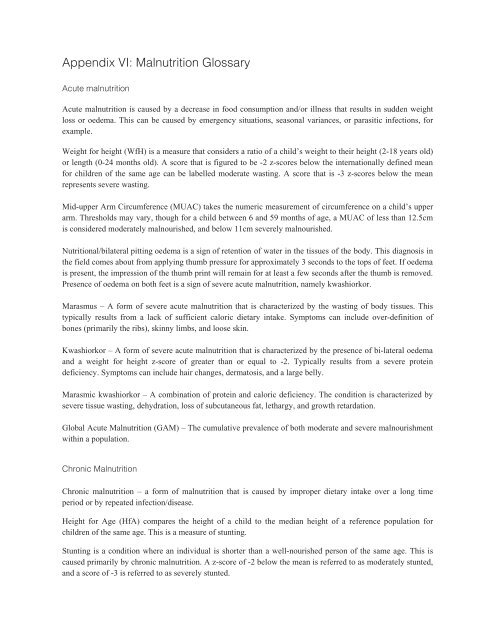Exploring livelihoods of the urban poor in Kampala, Uganda
Exploring livelihoods of the urban poor in Kampala, Uganda
Exploring livelihoods of the urban poor in Kampala, Uganda
You also want an ePaper? Increase the reach of your titles
YUMPU automatically turns print PDFs into web optimized ePapers that Google loves.
Appendix VI: Malnutrition Glossary<br />
Acute malnutrition<br />
Acute malnutrition is caused by a decrease <strong>in</strong> food consumption and/or illness that results <strong>in</strong> sudden weight<br />
loss or oedema. This can be caused by emergency situations, seasonal variances, or parasitic <strong>in</strong>fections, for<br />
example.<br />
Weight for height (WfH) is a measure that considers a ratio <strong>of</strong> a child’s weight to <strong>the</strong>ir height (2-18 years old)<br />
or length (0-24 months old). A score that is figured to be -2 z-scores below <strong>the</strong> <strong>in</strong>ternationally def<strong>in</strong>ed mean<br />
for children <strong>of</strong> <strong>the</strong> same age can be labelled moderate wast<strong>in</strong>g. A score that is -3 z-scores below <strong>the</strong> mean<br />
represents severe wast<strong>in</strong>g.<br />
Mid-upper Arm Circumference (MUAC) takes <strong>the</strong> numeric measurement <strong>of</strong> circumference on a child’s upper<br />
arm. Thresholds may vary, though for a child between 6 and 59 months <strong>of</strong> age, a MUAC <strong>of</strong> less than 12.5cm<br />
is considered moderately malnourished, and below 11cm severely malnourished.<br />
Nutritional/bilateral pitt<strong>in</strong>g oedema is a sign <strong>of</strong> retention <strong>of</strong> water <strong>in</strong> <strong>the</strong> tissues <strong>of</strong> <strong>the</strong> body. This diagnosis <strong>in</strong><br />
<strong>the</strong> field comes about from apply<strong>in</strong>g thumb pressure for approximately 3 seconds to <strong>the</strong> tops <strong>of</strong> feet. If oedema<br />
is present, <strong>the</strong> impression <strong>of</strong> <strong>the</strong> thumb pr<strong>in</strong>t will rema<strong>in</strong> for at least a few seconds after <strong>the</strong> thumb is removed.<br />
Presence <strong>of</strong> oedema on both feet is a sign <strong>of</strong> severe acute malnutrition, namely kwashiorkor.<br />
Marasmus – A form <strong>of</strong> severe acute malnutrition that is characterized by <strong>the</strong> wast<strong>in</strong>g <strong>of</strong> body tissues. This<br />
typically results from a lack <strong>of</strong> sufficient caloric dietary <strong>in</strong>take. Symptoms can <strong>in</strong>clude over-def<strong>in</strong>ition <strong>of</strong><br />
bones (primarily <strong>the</strong> ribs), sk<strong>in</strong>ny limbs, and loose sk<strong>in</strong>.<br />
Kwashiorkor – A form <strong>of</strong> severe acute malnutrition that is characterized by <strong>the</strong> presence <strong>of</strong> bi-lateral oedema<br />
and a weight for height z-score <strong>of</strong> greater than or equal to -2. Typically results from a severe prote<strong>in</strong><br />
deficiency. Symptoms can <strong>in</strong>clude hair changes, dermatosis, and a large belly.<br />
Marasmic kwashiorkor – A comb<strong>in</strong>ation <strong>of</strong> prote<strong>in</strong> and caloric deficiency. The condition is characterized by<br />
severe tissue wast<strong>in</strong>g, dehydration, loss <strong>of</strong> subcutaneous fat, lethargy, and growth retardation.<br />
Global Acute Malnutrition (GAM) – The cumulative prevalence <strong>of</strong> both moderate and severe malnourishment<br />
with<strong>in</strong> a population.<br />
Chronic Malnutrition<br />
Chronic malnutrition – a form <strong>of</strong> malnutrition that is caused by improper dietary <strong>in</strong>take over a long time<br />
period or by repeated <strong>in</strong>fection/disease.<br />
Height for Age (HfA) compares <strong>the</strong> height <strong>of</strong> a child to <strong>the</strong> median height <strong>of</strong> a reference population for<br />
children <strong>of</strong> <strong>the</strong> same age. This is a measure <strong>of</strong> stunt<strong>in</strong>g.<br />
Stunt<strong>in</strong>g is a condition where an <strong>in</strong>dividual is shorter than a well-nourished person <strong>of</strong> <strong>the</strong> same age. This is<br />
caused primarily by chronic malnutrition. A z-score <strong>of</strong> -2 below <strong>the</strong> mean is referred to as moderately stunted,<br />
and a score <strong>of</strong> -3 is referred to as severely stunted.

















